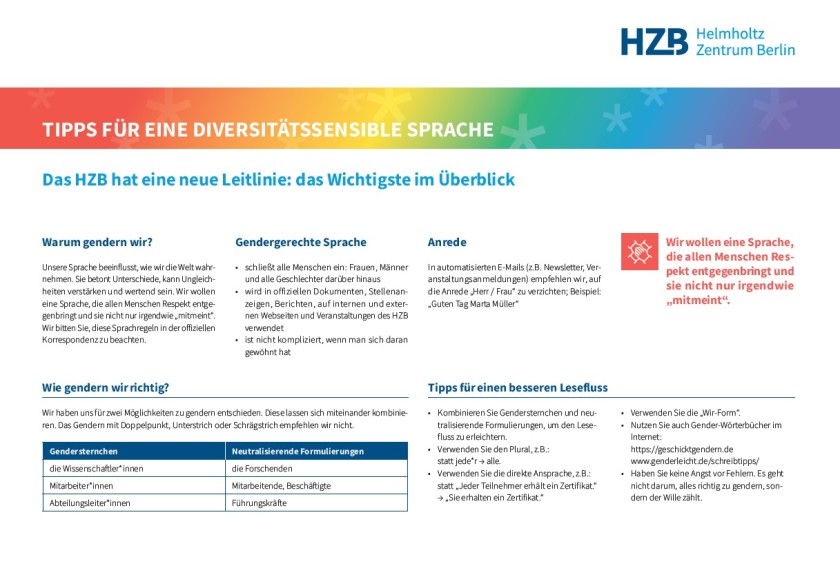Diversity-sensitive language

Since August 2021, HZB has a new Guideline for Diversity-Sensitive Language. Its purpose is to invite us to use our language more consciously, so that people of all genders are addressed equally.
We present the most important recommendations on this page. Consult our FAQ.
Diversity-sensitive language should be used:
- in official documents
- in job advertisements
- in reports
- in emails to a larger group of recipients and newsletters
- on internal and external websites
- for greetings at events
The implementation of diversity-sensitive language is a process that has just begun at HZB. We are working on it. That's why our web pages have not yet been completely changed.
The most important recommendations at a glance:
- Use neutral wordings or the gender star in German language
| Gendersternchen | Neutralisierende Formulierungen |
| die Wissenschafter*innen | die Forschenden |
| Mitarbeiter*innen | Mitarbeitende, Beschäftigte |
| Abteilungsleiter*innen | Führungskräfte |
- In English, it is also advisable to avoid formulations that are specific to any one gender. Example: chairman → chairperson
- the use of “singular they” – where “they” or “their” refers to a single person – is well established. Example: Each participant should bring their own computer for the workshop.
- A good greeting for emails or newsletters is “Dear First Name Last Name“ in English / or “Guten Tag First Name Last Name” in German (instead of using “Sehr geehrter Herr / geehrte Frau”)
- Pay attention to diversity in pictures and never use stereotypical representations of people.
Printable overview for using the German language
Print out this overview (in German) to have the most important recommendations and information at hand. (Tip as pdf-file, in German).
Frequently Asked Questions (FAQ)
Why does HZB use diversity-sensitive language?
Our language influences how we perceive the world. It stresses differences, can amplify inequalities and can be judgemental. With the guideline for genders-sensitive language, we hope to help people of all genders to feel that they are being addressed equally.
Is gender-sensitive language “monitored”?
No, the use of language is not monitored at HZB. Rather, the guideline is more an invitation to be mindful in using sensitive language, and offers recommendations. We know that it will take some time for such changes to become established.
Why is it not enough to simply refer to the male and female form together?
Gender-appropriate language is about making all people feel that they are being addressed and appreciated, including people with a non-binary gender identity. That is why we recommend neutral wordings or the gender asterisk||star.
Why do we recommend the gender asterisk|*|star?
There are many different types of punctuation used to represent genders in words, including a colon, underscore or slash. We have decided against those types because they only emphasise a binarity of genders. The gender asterisk|*|star stands as a symbol for many variables, and thus includes all gender identities. Alternatively, you can use gender-neutral wordings instead.
What might diversity-sensitive pictures look like?
Pictures all too often convey role clichés. It is therefore important for photos and videos to depict the diversity of our everyday realities (age, origin, appearance) wherever possible. You can find some good examples and suggestions in the guidelines of KIT, member of Helmholtz Association (pdf-file).

